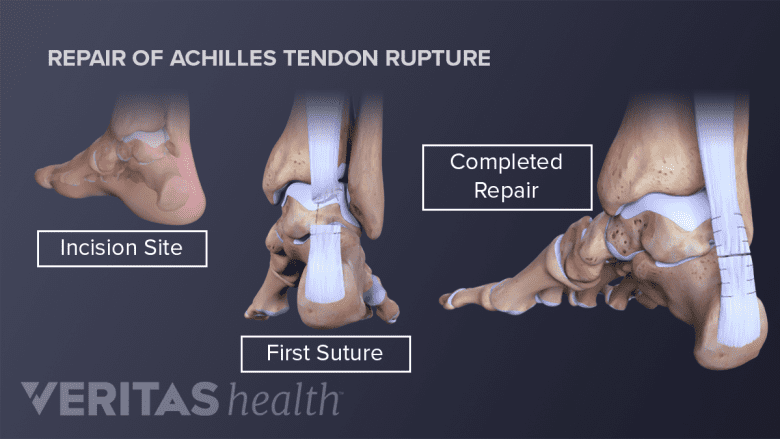When initial treatments fail to provide Achilles tendon healing and pain relief, a doctor may recommend injections or surgery.
In This Article:
- Achilles Tendonitis and Tendon Injuries
- Achilles Tendon Conditions Signs and Symptoms
- Causes and Risk Factors for Achilles Tendon Damage
- Diagnosing Achilles Pain
- Treating a Painful Achilles Tendon
- Injections and Surgery to Treat Achilles Pain
Injections and Tenotomy

PRP uses the patient's blood to repair damaged tissues like cartilage, tendons, ligaments, and muscles.
Steroid injections are commonly used to treat many orthopedic conditions, but are infrequently recommended for Achilles tendonitis or other Achilles tendon problems. A corticosteroid injection made directly into tendon tissue may weaken it and possibly put it at risk for further damage.
See What Is the Difference Between Tendonitis, Tendinosis, and Tendinopathy?
While cortisone injections may not be appropriate, other types of injections may be recommended.
Platelet rich plasma (PRP)
Injection of platelet rich plasma into the tendon to stimulate platelet growth and tissue healing at the injury site is an emerging therapy option; however, few clinical studies have found it to be significantly effective for treating the Achilles tendon.1Vannini F, Di Matteo B, Filardo G, Kon E, Marcacci M, Giannini S. Platelet-rich plasma for foot and ankle pathologies: a systematic review. Foot Ankle Surg. 2014 Mar;20(1):2-9. doi: 10.1016/j.fas.2013.08.001. Epub 2013 Aug 16. Review. PubMed PMID: 24480491. PRP injections may not be covered by insurance.
See PRP Therapy for Chronic Tendon Injuries
Brisement
Achilles paratenonitis, or the thickening of a segment of the tendon, does not always respond to nonsurgical treatment. These cases may be treated with brisement, in which the affected tendon is injected with a small amount of fluid, either sterile saline or lidocaine to break up scar tissue (adhesions) in the tendon.
Needle Tenotomy
A doctor performing this treatment uses a large-gauge needle to manipulate the tendon back and forth to create bleeding and tissue damage. While the initial procedure causes minor damage, the goal is to spur new healing.
These in-office procedures are typically followed up with relative rest and physical therapy. If the tendon does not satisfactory heal, a physician may recommend surgery.
Surgical Treatment

Repair of the Achilles tendon is performed from the back of the leg and involves a small incision.
Surgery is only considered when a person has difficult-to-treat chronic tendinopathy or a torn Achilles tendon. (Occasionally, an acute rupture of the Achilles tendon will be treated with casting of the foot and ankle rather than surgery.)
Whether a doctor recommends surgery, and what type of surgery he or she recommends, depends on the nature of the Achilles damage as well as the patient and his or her health, lifestyle, and preferences. Below are some of the most common surgeries associated with Achilles tendinopathy and tears.
Gastrocnemius recession
This surgical procedure lengthens the gastrocnemius (calf) muscle. When this muscle is too tight it puts added stress on the Achilles tendon. By lengthening the muscle gives the ankle a greater range of motion, and therefore puts less stress on the Achilles. Gastrocnemius recession and surgical debridement may be performed at the same time.
Débridement
This surgery involves the removal of diseased or damaged Achilles tendon tissue, with the hopes that new, healthier tissue will grow in its place. Debridement usually involves tendon repair or tendon transfer:
- Tendon repair attempts to secure the Achilles tendon to the bone using metal or plastic anchors.
- Tendon transfer is done when more than half the Achilles tendon is damaged and the remaining tendon is at risk of rupture. During this procedure a tendon from the big toe is removed and transferred to the back of the heel to reinforce the damaged Achilles tendon. While many patients will eventually be able to walk and even jog after this surgery, athletes may not be able to return to competitive sports participation.
Surgery is rarely needed for younger patients with an Achilles tendon injury. When indicated, however, most young people and active people of all ages with Achilles tendinopathy benefit from early surgical repair rather than putting it off for too long.
- 1 Vannini F, Di Matteo B, Filardo G, Kon E, Marcacci M, Giannini S. Platelet-rich plasma for foot and ankle pathologies: a systematic review. Foot Ankle Surg. 2014 Mar;20(1):2-9. doi: 10.1016/j.fas.2013.08.001. Epub 2013 Aug 16. Review. PubMed PMID: 24480491.

